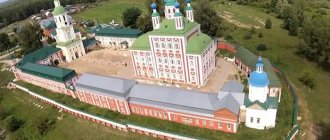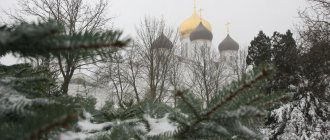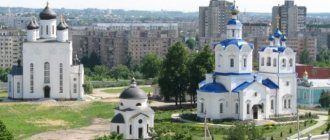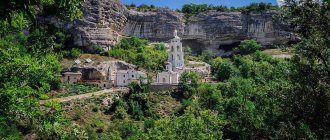Mir
Russia Leningrad Region Tikhvin Tikhvin Mother of God Assumption Monastery Map loading in progress...
{"format":"leaflet","minzoom":false,"maxzoom":false,"limit":50,"offset":0,"link":"all","sort":[""], "order":[],"headers":"show","mainlabel":"","intro":"","outro":"","searchlabel":"\u2026 \u0441\u043b\u0435\ u0434\u0443\u044e\u0449\u0438\u0435 \u0440\u0435\u0437\u0443\u043b\u044c\u0442\u0430\u0442\u044b","default":"","import-annotation":false,"width ":"auto","height":"350px","centre":{"text":"","title":"""link":"""lat":59.65294999999999703277353546582162380218505859375,"lon": 33.52068299999999823057805770076811313629150390625,"icon":""},"title":"","label":"","icon":"","lines":[],"polygons":[],"circles":[ ],"rectangles":[],"copycoords":false,"static":false,"zoom":8,"defzoom":14,"layers":["OpenStreetMap"],"image layers":[] ,"overlays":[],"resizable":false,"fullscreen":true,"scrollwheelzoom":true,"cluster":false,"clustermaxzoom":9,"clusterzoomonclick":true,"clustermaxradius":80, "clusterspiderfy":true,"geojson":"","clicktarget":"","showtitle":true,"hidenamespace":false,"template":"","userparam":"","activeicon": "","pagelabel":false,"ajaxcoordproperty":"","ajaxquery":"","locations":[{"text":"\u003Cb\u003E\u003Ca href=\"/palomnik/%D0% A2%D0%B8%D1%85%D0%B2%D0%B8%D0%BD%D1%81%D0%BA%D0%B8%D0%B9_%D0%91%D0%BE%D0%B3% D0%BE%D1%80%D0%BE%D0%B4%D0%B8%D1%87%D0%BD%D1%8B%D0%B9_%D0%A3%D1%81%D0%BF%D0% B5%D0%BD%D1%81%D0%BA%D0%B8%D0%B9_%D0%BC%D1%83%D0%B6%D1%81%D0%BA%D0%BE%D0%B9_% D0%BC%D0%BE%D0%BD%D0%B0%D1%81%D1%82%D1%8B%D1%80%D1%8C\» title=\»\u0422\u0438\u0445\u0432\ u0438\u043d\u0441\u043a\u0438\u0439 \u0411\u043e\u0433\u043e\u0440\u043e\u0434\u0438\u0447\u043d\u044b\u0439 \u0423\u0441\u0 43f\u0435\u043d\u0441\u043a\ u0438\u0439 \u043c\u0443\u0436\u0441\u043a\u043e\u0439 \u043c\u043e\u043d\u0430\u0441\u0442\u044b\u0440\u044c\"\u003E\u0422\ u0438\u0445\u0432\u0438\ u043d\u0441\u043a\u0438\u0439 \u0411\u043e\u0433\u043e\u0440\u043e\u0434\u0438\u0447\u043d\u044b\u0439 \u0423\u0441\u043f\u0 435\u043d\u0441\u043a\u0438\ u0439 \u043c\u0443\u0436\u0441\u043a\u043e\u0439 \u043c\u043e\u043d\u0430\u0441\u0442\u044b\u0440\u044c\u003C/a\u003E\u003C/ b\u003E\u003Chr /\u003E \u003Ca href=\"/palomnik/%D0%A1%D0%B2%D0%BE%D0%B9%D1%81%D1%82%D0%B2%D0%BE:%D0%90%D0%BD %D0%BD%D0%BE%D1%82%D0%B0%D1%86%D0%B8%D1%8F\" title=\"\u0421\u0432\u043e\u0439\u0441\u0442\u0432\u043e :\u0410\u043d\u043d\u043e\u0442\u0430\u0446\u0438\u044f\»\u003E\u0410\u043d\u043d\u043e\u0442\u0430\u0446\u0438\u044f\u003C /a\u003E:\u041e \u0441\u043d\u043e\u0432\u0430\u043d \u043f\u043e \u0443\u043a\u0430\u0437\u0443 \u0418\u0432\u0430\u043d\u0430 \u0413\u044 0\u043e\u0437\u043d\u043e\u0433 1560 1560 43e\u0440\u043e\u0434\u0441\u043a \u0438\u043c \u0430\u0440\u0445\u0438\u0435\u043f\u0438\u0441\u043a\u043e\u043f\u043e\u043c \u041f\u0438\u043c\u0435\u043d\ u043e\u043c","title": "" u044b\u0439\u0423\u0441\ u043f\u0435\u043d\u0441\u043a\u0438\u0439 \u043c\u0443\u0436\u0441\u043a\u043e\u0439 \u043c\u043e\u043d\u0430\u0441\u0442\u0 44b\u0440\u044c","link" :"","lat":59.65294999999999703277353546582162380218505859375,"lon":33.52068299999999823057805770076811313629150390625,"icon":""}]" imageLayers":[]}
59.653162; 33.521102
Russia, Leningrad region, Tikhvin, Tikhvinskaya street, 1
Tikhvin, Leningrad region 187555
Russia
Telephone:
8(81367) 51-084, 8(81367) 35-084
Email:
(on general issues), and (on issues of pilgrimage trips)
Tikhvin Mother of God Assumption Monastery
- an Orthodox monastery, located in the city of Tikhvin, on the banks of the Tikhvinka River.
History[edit]
Founded by decree of Ivan the Terrible on February 10, 1560 by Novgorod Archbishop Pimen.
In 1613, the monastery was besieged by the Swedish army led by Jacob Delagardie, but its defenders, led by Prince Semyon Prozorovsky, were able to repel several assaults and hold the monastery until reinforcements arrived.
In the 1920s, the monastery churches were transferred to the renovationists, closed in the 1930s, and the icon, considered miraculous, became an exhibit of the local history museum.
During the Great Patriotic War, the city was occupied only for a short time by German troops, but during the retreat they took the icon to Pskov, where they handed it over to the Orthodox spiritual mission, then the icon ended up in Riga, Libau, Yablontsy, the American occupation zone in Germany, from there Bishop John (Garklavs) took her to Chicago (USA). Dying, Bishop John left a will, according to which the return of the shrine to Russia is possible only with the complete revival of the Tikhvin Monastery.
In 1945, the Church of the Tikhvin Icon of the Mother of God “Porch”, located in the eastern tower of the monastery fence, built according to the design of N. L. Benois and consecrated in 1863, was provided for use by the Orthodox community (for more than 40 years it was the only functioning church on the territory of Tikhvin and Boksitogorsky districts).
In 1995, the monastery was transferred to the Russian Orthodox Church, the Assumption Cathedral was restored and consecrated, and in 2004 the icon was returned to the monastery.
See also:
Historical and statistical description of the first-class Tikhvin Bogoroditsky large monastery of the Novgorod diocese in the city of Tikhvin (1859, 135 pages)
Tikhvin Mother of God Assumption Monastery Diocesan monasteries of the Russian Orthodox Church
In 1383, 70 years before the fall of Constantinople, “this icon of Hodegetria was taken from it by the mania of God and transferred to Rus'.” The image of the Mother of God miraculously disappeared through the air from Constantinople and appeared to fishermen over Lake Ladoga, near the ancient capital of Rus', Staraya Ladoga. The Patriarch of Constantinople, having listened to the testimonies of Novgorod merchants and their descriptions of the image, confirmed that the icon revealed in Rus' is the same one that left Byzantium irrevocably “for pride, brotherly hatred and the lies of the people.” The icon moved to the Tikhvin land shortly after the victory of the united Russian troops under the command of the blessed Prince Dimitry Donskoy over the hordes of Mamai. According to the chronicle, “in the summer of 6891 from the Creation of the world, on the 26th day of June (July 9, 1383 AD), the icon of the Most Pure Image of Hodegetria appeared in the region of Great Novagrad, called Tikhfin.” Priests with a multitude of people came here, to the bank of the Tikhvinka River, and during fervent congregational prayer the icon descended into the hands of those praying. Without delay, they began to build the temple: on the same day they cut down the forest, managed to make three crowns, assigned guards to the construction site and, glorifying God, went home until morning. But the assigned guards fell asleep from fatigue, and when they woke up, they discovered that there was neither an icon, nor the beginning of a log house, nor even chips from the felled and hewn timber.
People gathered. Everyone began to mourn the loss bitterly, and then began to search everywhere for the icon. And—oh, a miracle!—the icon was discovered on the other side of the river, along with the beginning of the log house and the prepared logs. So the icon itself finally chose its place of residence. And although the place was “criminal and uneven,” it was precisely this place that the Mother of God indicated. This means that it was here that the first Church of the Assumption was to be built, which was done without delay by the whole world and the generosity of donors.
Upon completion of construction, sexton Yurysh, a pious man, was sent to notify the surrounding residents about the time of the consecration of the temple. Not far from the new temple, the Mother of God appeared to Yurysh with St. Nicholas the Wonderworker and commanded, through the lips of the saint, to put a wooden cross on the temple, not an iron one, because it was on the wooden cross that Jesus was crucified. At the same time, a chapel was erected at the site of the conversation between St. Nicholas and Yurysh, and in the 16th century the St. Nicholas-Besedny Monastery was founded. This event also served as the basis for painting the icon. Contemporaries, however, did not immediately believe Yurysh, and when they began to install a forged iron cross on the dome, the worker who did this was removed from the dome along with the cross by an invisible force and a blow of wind and placed on the ground unharmed. The crosses on the cathedral are all wooden to this day.
The first church stood for seven years and burned down from a “candle at night,” but the miraculous icon was preserved intact: it was found nearby in a juniper tree. The church burned three times and was restored three times, and each time the icon miraculously remained unharmed. The fame of the miracles of the icon spread far beyond the borders of the region, and in 1507, by decree of Tsar Vasily III, the stone Assumption Church was founded - five-domed and “gloriously visible to everyone from everywhere...”. During these years, the miraculous icon received the name Tikhvin
Ivan IV the Terrible, who revered the Tikhvin image of the Mother of God with special reverence, came in 1547 together with Metropolitan of All Rus' Macarius. The young Grand Duke was to become the first crowned Russian monarch, and his arrival was part of the preparatory program of celebrations developed by the Metropolitan. Ivan Vasilyevich’s prayer “at the Most Pure One on Tikhvin” was undertaken with the aim of gaining heavenly approval for the wedding to the kingdom. After all, the wedding of the Russian Tsar finally cemented the inheritance of the status of a true Orthodox empire from Byzantium to Russia. A new Christian power, based on the commandments of the strong Orthodox faith, was born and gaining strength.
With such attention from the authorities and people to the monastery, he did not experience a shortage of guardians and donors. So in 1584, Tsar Fyodor Ioannovich donated a 300-pound polyeleos bell. After the fire of 1623, a collection of donations and contributions of icons for the burned iconostasis of the cathedral was announced—both noble and ordinary citizens, Tikhvin and Novgorod residents donated. The tradition did not stop later. In 1630, Mikhail Fedorovich, the first of the Romanov dynasty, contributed 3,000 sheets of white iron from his personal funds to cover the domes of the Church of the Assumption. Prince Dmitry Pozharsky, the leader of the militia that liberated the country from the Lithuanian-Polish intervention, sent masons to restore the belfry, destroyed by the explosion of a gunpowder warehouse.
Soon after its founding and especially during the Livonian campaigns of Ivan IV the Terrible, the Assumption Monastery, located at that time on the northwestern border of Russia, began to carry out not only spiritual and educational, but also an important and dangerous state “sentinel and communications” service.
End of the 16th century became a time of aggravation of Russian-Swedish relations, and at the beginning of the 17th century. the country was plunged into the difficult trials of the Time of Troubles. During those tragic events, one of the Pskov bishops, having received news of the capture of Moscow and the siege of the Trinity-Sergius Lavra, “died of grief.” It was not only the Tikhvin Monastery that was repeatedly subjected to siege and “Luthor’s misfortune”, but it truly suffered more than its share. The chronicler saw the causes of these misfortunes in “arrogance and sinful impurities.”
In 1610 - “Lithuanian ruin”: the Tikhvin monastery was plundered by Polish-Lithuanian troops. From 1608 to 1613 there were repeated clashes with the troops of the Swedish commander Jacob Delagardie, who, under the pretext of helping the Shuisky government, occupied the monastery, turning it into their garrison. Unable to suffer shame, the Tikhvinites attacked the Swedes and drove them out of the monastery. In response, the Swedes returned with reinforcements, and Delagardi ordered not to leave stone unturned from the monastery-fortress.
The end of the summer of 1613 became the time of the heroic “siege” of the Russian detachment and the Tikhvin militia. And in the most difficult hour, when the enemy, having received reinforcements, began to prevail, the Heavenly Intercessor again showed her protection. On September 15, 1613, the defenders of the monastery finally defeated the detachments of Swedish interventionists: the turning point came when the besieged came to the wall of the monastery with the Tikhvin Icon of the Mother of God. The Mother of God performed a miracle: as the captured Swedes later said, their entire detachment in fear dreamed that a countless Russian army was coming to the aid of the monastery from all sides. They were “disturbed, shaken and afraid to flee with the cold, beating each other from behind.”
In June 1812, Archimandrite Samuil of the monastery blesses the Tikhvin squad going to war with Napoleon with a copy of the miraculous icon. The list accompanied the squad in victorious battles and received the name “Tikhvin Militia Icon of the Mother of God.”
In the mid-20s of the twentieth century. the monastery was closed and destroyed by the apostate authorities, like many other churches and monasteries. During the Great Patriotic War, Tikhvin was the scene of fierce battles with the Nazi invaders, who sought to close the second blockade ring around Leningrad. Having occupied Tikhvin in November 1941, the Nazis stole all the ancient icons from the monastery, among which was the Tikhvin Icon of the Mother of God. The icon came to occupied Pskov, and then in 1944 to Riga. The invaders hoped to gain the support of the Orthodox by “releasing” the icon for the duration of services in churches in the occupied territory. But during the retreat, the Nazis did not have time to take the miraculous image.
From Riga through Liepaja, Gdansk, Koblenz and Prague, through refugee camps and the hardships of exile, at the risk of his life and the safety of the shrine, the icon was preserved and taken to the USA by the then Bishop of Riga and the future Archbishop of Chicago and Minneapolis John († 1982). All the years of forced exile, the shrine was carefully preserved by the ruler, who bequeathed to return it to its homeland when Russia was freed from the power of the destroyers of Christianity. The keeper of the icon, the adopted son of Bishop John, Archpriest Sergius Garklavs, who was still a youth during the war, carried the miraculous image on his shoulders literally through fire and water.
The miraculous icon, a shrine of world Orthodoxy, was in the custody of Father Sergius in Chicago, Illinois, for 63 years. In 2003, he made the final decision to return the image to the restored Tikhvin monastery.
In April 1995, residents of the city of Tikhvin addressed an open letter to the Patriarch of Moscow and All Rus' Alexy II with a request to bless the opening of the Mother of God Assumption Monastery - the holy monastery to which the city of Tikhvin owes its appearance. A month later, the religious association “Tikhvin Mother of God Assumption Monastery” was registered. In the same year, the first inhabitants moved into the monastery, who, together with pilgrims, began restoration and construction work to restore the monastery. The first monastic tonsure was performed in an already operating monastery. A year later, the festive service resumed. On July 9, 1997, the first bishop's service took place in the Assumption Cathedral of the monastery, led by His Eminence Metropolitan Vladimir of St. Petersburg and Ladoga.
In the spring of 2003, a final agreement was reached on the return of the Tikhvin icon to its native monastery. At the request of the custodian of the image, Archpriest Sergius Garklavs, the icon’s first stop after the flight from America was in Riga, then Moscow, St. Petersburg and, finally, the Tikhvin Monastery.
The miraculous Tikhvin Icon of the Mother of God returned to its homeland on June 23, 2004. On the day of the church-wide celebration of the appearance of the image on July 9, 2004 (June 26, Old Style), the solemn liturgy was served in the Tikhvin Monastery by Patriarch Alexy of Moscow and All Rus', co-served by the Primate of the Orthodox Church in America Metropolitan Herman and a host of clergy.
List of temples and hermitages of the Tikhvin Monastery[edit]
Temples[edit]
Assumption Cathedral
. The oldest, largest and most beautiful Assumption Cathedral was erected in 1515, under Vasily III; It was rebuilt many times and acquired extensions, so that it now combines elements of many architectural styles from the 16th to the 20th centuries. The Tikhvin Icon of the Mother of God is kept here.
Intercession Church and its belfry
. The temple was built in the 16th century, in the 19th century it received a new look, but in the 1960-70s, restorers restored the monument as it appeared. The Tikhvin Icon is kept in the Intercession Church in winter.
Gate Church of the Ascension of the Lord
originally from the 16th century (the brainchild of the blessed sovereign Theodore Ioannovich).
Church of the Twelve Apostles
erected at the monastery hospital at the end of the 17th century, rebuilt in the 19th century, and during the Great Patriotic War it lost the entire altar part and the top. Now in the church there is an icon shop of the monastery.
Holy Cross Cathedral
built at the dawn of the reign of Peter the Great, and under Alexander III it was crowned with five domes. Divine services are held there in winter.
Church of the Tikhvin Icon of the Mother of God “Porch”
. In 1669, the Gate Tower was erected on the spot where the Tikhvin Icon stood before the construction of the Assumption Cathedral. The fresco with the image of the Virgin Mary on the facade of the tower, to which a staircase of 24 steps led (hence the name “Porch”) served to heal the tradesman A. A. Borovsky. In memory of this healing, the Church of the Tikhvin Icon of the Mother of God “Porch” was added to the tower, so that the icon was inside the altar. The temple was returned to the Church in 1944 and even during the Soviet years it became a place of pilgrimage: many came here to be baptized or get married.
According to the order of the great monasteries
In 1560, on the banks of the Tikhvinka River, the foundation of a holy monastery was laid in honor of the Tikhvin Icon of the Mother of God, Intercessor of the Russian Land and Guide of Orthodox Christians. Above the arches of the holy gates, a fragment of the inscription has been preserved: “By the grace of Christ and the favor of our Most Holy Lady Theotokos and Ever-Virgin Mary and with that help, by the command of the Tsar and Grand Duke John Vasilyevich of All Russia, this monastery began and was established in the summer of February 7068 on the 11th day.” Solemn services on this occasion were held in the presence of the royal family in the Moscow Assumption and Novgorod St. Sophia Cathedrals. In the spring and summer of the same year, the monastery was cut down, wooden at first, but solid and spacious “in the order of great monasteries.”
The monastery was destined to become the home of the greatest Orthodox shrine, to survive both glorious and troubled times, to serve as a line of defense against foreign invaders, while always remaining a source of pure spiritual radiance, to which pilgrims from all over Orthodox Russia sought.
Compound of the Tikhvin Monastery[edit]
- Home church of St. Dimitri Metropolitan of Rostov. Compound of the Tikhvin Monastery. St. Petersburg, st. Degtyarnaya, 18A
- Compound of the Tikhvin Mother of God Assumption Monastery in the city of Pikalevo. Leningrad region, Boksitogorsky district, Pikalevo
- Holy Dormition Makaryevskaya hermitage, Leningrad region, Tosnensky district
- Chapel of the Tikhvin Icon of the Mother of God in the town of Smolensky Shlyuz. Leningrad region. Tikhvinsky district, Lazarevicheskaya volost, Smolensky Shlyuz town.
Abbesses
- Eupraxia - 1608
- (Daria (Koltovskaya), queen-nun - presumably)
- Agathia (mentioned 1613 and in the spiritual letter of Daria (Koltovskaya), dated March 31, 1626)
- Euronia - 1632
- Euraisa - 1656
- Platonida (Princess Gagarina), niece of Abbess Daria - 1642
- Platonida - 1669
- Izmaragda - 1675
- Martha - defined in May 1675 and retired on August 16 of the same year
- Taisiya - 1677
- Eudoxia - 1678
- Paraskeva - 1686
- Eudoxia - 1691 (secondary)
- Juliania - 1692
- Euronia - 1696
- Eudoxia - 1700
- Capitolina - 1703
- Euronia - 1705 (secondary)
- Olga - 1722
- Dorothea - 1738
- Alexandra - 1743
- Elpidifora - retired on March 12, 1761.
- Nymphodora - transferred from Syrkov Monastery (1761); retired
- Natalia - transferred from Desyatinsky Monastery; retired in 1780
- Maria († 1805)
- Taisiya (Chertova) (1805-1823) from the nobility, former treasurer of this monastery
- Augusta (Sveshnikova) (1823 - February 21, 1858) from the Novgorod Zverin Monastery
- Serafima (Timkovskaya) (1858-1876) from the nobility
- Raphaila (Varnot) (October 14, 1876 - November 18, 1900) from the nobility
- Apollinaria (Vladykina) (1901 - May 14, 1918)
- Joannikia (Kozhevnikova) (1918-1929) canonized in 2002
- Tabitha (Fedorova) (since December 25, 2009)
Shrines[edit]
- Tikhvin Icon of the Mother of God
The miraculous appearance of the icon on the banks of the Tikhvinka River dates back to 1383. For it, a wooden church of the Assumption of the Virgin Mary was built on the site of the appearance, which in 1515 was rebuilt into a stone one, around which the Tikhvin Monastery grew. After the revolution, the icon was in the Museum of Local Lore, in 1941 it was taken by the Germans to Pskov and transferred to the Pskov Spiritual Mission. She “retreated” along with the Germans, then stayed in Germany, and in 1950 she was taken to the Holy Trinity Cathedral in Chicago. Its guardians were Archbishop John (Garklavs) of Riga, and then his adopted son Archpriest Sergius Garklavs. In 2004, the icon was returned to the monastery.
- Icon of the Mother of God “Starorusskaya”
Prayers to the Mother of God in front of Her Tikhvin Icon
Troparion, tone 4
Today, like the bright sun, Your all-honorable icon, O Lady, has risen for us in the air, illuminating the world with rays of mercy, even great Russia, like some gift from the Divine above reverent Having truly accepted, he glorifies Thee, Mother of God, the Lady of all, and from Thee the Christ born of our God magnifies joyfully . Pray to Him, O Lady Queen Theotokos, that He may preserve all Christian cities and countries unharmed from all the slander of the enemy and save through faith those who worship His Divine and Thy evils According to this image, the Unartful Virgin.
Translation: On this day, like the bright sun, Your all-holy icon, O Lady, shone for us in the air, illuminating the world with rays of mercy! Her great Russia, having reverently accepted a certain Divine gift from above, glorifies You, Mother of God, the Lady of all, and joyfully magnifies Christ, our God, who was born from You. Pray to Him, O Lady Queen Theotokos, that He may preserve all Christian cities and countries unharmed from all the machinations of the enemy and save with faith those who worship His Divine and Your most pure image, the Virgin who has not known marriage.
Kontakion, tone 8
Let us come, people, to the Virgin Mother of God Queen, thanking Christ God, and, looking tenderly at that miraculous icon, let us fall and cry out to Her: O Lady Mary, who has come to this land of Thy honor This image appeared miraculously, save our fatherland and all Christians in peace and prosperity , heirs showing Heavenly lives, We truly call to You: Rejoice, Virgin, salvation of the world.
Translation: Let us resort, people, to the Virgin Mother of God Queen, thanking Christ God, and, looking at Her miraculous icon with tenderness, let us fall and exclaim to Her: “O Lady Mary, having visited this country of Your sacred image with a miraculous appearance, preserve the Fatherland in peace and prosperity ours and all Christians, revealing them to be heirs of Heavenly life, for we cry to You with faith: Rejoice, Virgin, salvation of the world!”
Prayer
We thank You, O Most Blessed and Most Pure, Most Blessed Virgin, Lady, Mother of Christ our God, for all Your good deeds, which You have shown to the human race, especially to us, those named in Christ Russian people, about them below the most angelic language will be pleased with praise. We thank You, as even now You have surprised Your ineffable mercy on us, Your unworthy servants, with the natural self-coming of Your Most Pure Icon, which You have enlightened all of Russia Russian country.
Likewise, we, sinners, worshiping with fear and joy, cry out to Thee: O Most Holy Virgin, Queen and Mother of God, save and have mercy on Thy people, and grant them victory over all their enemies, and preserve the kingdom ruined cities, and all Christian cities and countries, and deliver this holy temple from every slander of the enemy, and grant everything for the benefit of all, who have now come with faith and as Thy servants praying, and who worship Thy Most Holy Image, for blessed art Thou with the Son and God born of You, now and ever and unto ages of ages . Amen.
Read us conveniently on social networks:
Tags: Tikhvin Mother of God Assumption Monastery, Tikhvin Monastery, Tikhvin Monastery, Tikhvin Assumption Monastery
Patronal holidays[edit]
- Icon of the Blessed Virgin Mary “Tikhvin”
- July 9 - Assumption of the Blessed Virgin Mary
- August 28 - Intercession of the Blessed Virgin Mary
- October 14 - Ascension of the Lord
- 40th day after Easter - Peter and Paul, chief apostles
- July 12 - Exaltation of the Life-Giving Cross of the Lord
- September 27 - February 21 (repose in 319), June 21 (transfer of relics in 319). Vmch. Theodora Stratelates (319)
Buildings and structures of the monastery
- Church of the Entry of the Virgin Mary with the chapels of St. Nicholas and St. Kirill of Belozersky (1645)
- Gate church with a bell tower (1645) of the saints Great Martyr Catherine and Martyr Queen Augusta. (Perestroika and reconstruction 1834-1836) architect I. I. Charlemagne. At the beginning of the twentieth century, the bell tower contained 9 bells, the largest weighed 2.5 tons, the second largest (1280 kg) was cast in 1652
- Church of the Nativity of the Blessed Virgin Mary, refectory church, (1645), architect P. Baranov
- Igumensky building
- Monastic building (“Leushinsky”)
- Residential buildings (2 wooden and 1 stone)
Links[edit]
- Official site
- Historical and statistical description of the first-class Tikhvin Bogoroditsky large monastery of the Novgorod diocese in the city of Tikhvin (1859, 135 pages)
- Tikhvin Mother of God Assumption Monastery. Photo
- Tikhvin Monastery. Photo
- Tikhvin Mother of God Assumption Monastery. Photowalks
- Photo: Tikhvin Shrine
Interesting Facts
- Nikolai Andreevich Rimsky-Korsakov was baptized in the Vedeno Monastery: “On April 27, 1844, in the Tikhvin Vvedensky Monastery, the son of the actual state councilor Andrei Petrovich Rimsky-Korsakov and his wife Sofia Vasilievna was baptized and the baby was named Nikolai.” Now on the territory of the monastery there is an archive of the museum named after. N. A. Rimsky-Korsakov.
- During the abbotship of Abbess Seraphima in 1861, Maria Solopova (from the noble family of the Solopovs) entered the monastery, called to monasticism by a vision of the Tikhvin image of the Mother of God. For many, about 10 years, she fulfilled her obedience and also taught children in a monastery school. At the Vvedensky Monastery on May 13, 1870, the novice Maria took monastic vows with the name Arkady. The future abbess of the Leushinsky Monastery, Abbess Taisiya, called the Vvedensky Tikhvin Monastery “her monastic cradle.”
- Under Abbess Raphael, an orphanage for orphan girls was opened in the Vvedensky Monastery in memory of the miraculous rescue of Emperor Alexander III and his family during a train crash near Borki station on October 17, 1888. When the orphanage opened, 12 girls were accepted into the orphanage, and by 1914 there were already 23 pupils.
- On June 19, 1859, Emperor Alexander II visited the monastery. The Emperor visited the Vvedensky Cathedral and the abbot's cells. In memory of his visit, the emperor sent brilliant priestly vestments to the monastery, a golden cross for the Abbess from His Majesty’s office, and an excellent rosary made of multi-colored stones with diamond decorations for the Treasurer of the monastery, nun Sophia.
- The monastery was visited by the Lokhvitsky sisters: Nadezhda (Teffi) and Maria (Mirra), who came from St. Petersburg to visit their uncle, the Tikhvin merchant of the second guild Joseph Vladimirovich Lokhvitsky. On August 23, 1892, the wedding of Maria Alexandrovna Lokhvitskaya and a graduate of the Faculty of Law of the Imperial St. Petersburg University Evgeniy Ernestovich Zhiber took place in the Vvedensky Cathedral.
An image from biblical times
This miraculous icon, with which the entire history of the monastery is inextricable, is unique in that its creation is associated with the name of the holy evangelist and apostle Luke. According to legend, the image was painted by him during the stay of the Blessed Virgin in Jerusalem. Seven decades before the fall of the Byzantine capital of Constantinople, the icon, by the will of God, was transferred from there to the shores of Ladoga and in 1383 appeared to the eyes of pious fishermen who were casting nets into the cold waters of the northern lake.
She became known as Tikhvin, after her place of residence, and soon the fame of the miracles revealed through her by the Blessed Virgin spread throughout Rus'. In honor of such a wonderful gift, bestowed by the Grace of God, a monastery was founded, above the gates of which an inscription has been preserved to this day, certifying the year of construction - 7068th from the creation of the world, which corresponds to 1560 according to our chronology, originating from the Nativity of Christ.
Frescoes and carvings by ancient masters
The painting of the cathedral that has survived for many years is very interesting. Its author is the famous icon painter of the late 18th century - Login Shustov. His frescoes, painted on top of previously lost images created by masters of the Novgorod school in the 16th century, have reached us in excellent condition.
One of the attractions of the cathedral, in which the Tikhvin Assumption Monastery of the Mother of God keeps the shrine sent down to it, is the carved iconostasis - the work of masters of the 17th century. Despite the fact that it is filled with icons of modern writing (the ancient originals are in the collections of the State Russian Museum), it can be classified as a unique example of applied art.
The Gate Church, which survived hard times
It is impossible not to mention another building of great artistic and historical interest. This is the gate church of the monastery, which during the Soviet period remained the last one that did not stop its activities in the entire region. It is known that in 1669 the main entrance to the monastery was decorated with a stone tower called the Vvedensky Gate. Two years later, a church was built in its upper tier, where the shrine was placed, for the veneration of which the flow of pilgrims never ceased to come to the monastery. In 1860-1865, the wooden staircase leading to the image was replaced by a stone one, built according to the design of the famous architect N. L. Benois and called the “Porch”.










